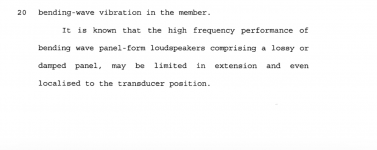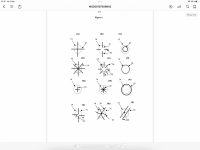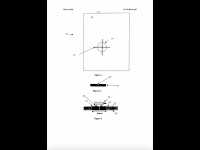No, it doesn't confirm anything. You are right only in "we are not following the same way" and nothing else. You see, the oldtimers are still doing the same thing, the same old process, with no real result, for years. There were few good implementations by the newcomers, which inspires.It confirms we are not following the same way.
Remember that sudden moment of mirth (#9,030) about the poor soil and rocks?
That jolted my memory, and actually reminded me of certain types of rocks which had been considered as the surface material, top and under surfaces, of the DM radiator panel. A certain types of rocks are actually used by some makers of DMLs, in their thinly crushed form, to improve the acoustic qualities of the surface layer. Soil, after all, is produced by rocks, through the processes of weathering and natural erosion, its parent material. Sure, we are not following the same way.
Could you please write more about your creation? Some photos, if possible? ThanksI cover the holes with 3m acoustic thinsulate and wool felt. Not like bass reflex, like leaky sealed box or aperiodic enclosure.
I have tested one of the solutions included in this patent application. I have included in one of my sandwich (carbon, balsa, carbon) a piece of homegenoius carbonfiber piece that is of the same size as the voice coil of the exciter 25mm. The CF piece is of the same thicknes as the balsa core 2mm. It’s Connecting the front and back CF skin with the exciter. It did help to extend the frequency range to 20k.I think that the compressive strength is a major factor. With low density eps for example, the very high accelerations at hf cause the foam to compress locally rather than follow the exciter movement. Also damping affects HF more than LF. I doubt it has to do with the density itself, I would expect low density to assist at HF with compressive strength and damping held constant.
There are some more ideas in the application.
’Thomas



Attachments
Everyone here knows thats not what they meant when they listed soil. LOL For cardbored most used Shellac. For EPS I tried wood fiber grain filler dilluted with water (make sure its the water based one) and it comes down to personal preference. I didnt care for the sound as it made it sound like paper in which its more accurate sounding but less lively and more on the duller side. I like my panels to sound more lively a bit on the brighter side.No, it doesn't confirm anything. You are right only in "we are not following the same way" and nothing else. You see, the oldtimers are still doing the same thing, the same old process, with no real result, for years. There were few good implementations by the newcomers, which inspires.
Remember that sudden moment of mirth (#9,030) about the poor soil and rocks?
That jolted my memory, and actually reminded me of certain types of rocks which had been considered as the surface material, top and under surfaces, of the DM radiator panel. A certain types of rocks are actually used by some makers of DMLs, in their thinly crushed form, to improve the acoustic qualities of the surface layer. Soil, after all, is produced by rocks, through the processes of weathering and natural erosion, its parent material. Sure, we are not following the same way.
Neither Shellac nor wood fibre grain filler is soil or rock. Good night!Everyone here knows thats not what they meant when they listed soil. LOL For cardbored most used Shellac. For EPS I tried wood fiber grain filler dilluted with water (make sure its the water based one) and it comes down to personal preference
It's interesting to note the vast difference between the inductance of my favourite exciter DAEX25SHF-4 (0.41mH) with those of the Tectonic BMR drivers TEBM65C20F-4 and -8 (0.03 and 0.05 respectively), and the Fs values of 365 (DAEX) and 97,104 (TEBM -4 and -8)For now I am in the opinion there are 2 low pass filters in DML :
- The voice coil inductance combined with the voice coil resistance that reduce the driving force when the frequency increases.
- The voice coil mobile mass combined with the panel mechanical impedance at the driving point. Here the difficulty is for light membrane which have a low mechanical impedance. It is here the proposal of test with heavier material comes to see if it is a factor.
All of these are so called full range 25mm voice coil units but drastically different motors. I've ordered some of the -4 and -8 to play around with - this hobby is a bit too addictive!
Eucy
The point is its not soil or rock in there natural form. Shellac and wood grain fiber filler are not in there natural form. Its used to harden the panel at the same time damping the panel like a layer of skin.Neither Shellac nor wood fibre grain filler is soil or rock. Good night!
Diatomaceous Earth is not in its natural form nor is Chitosan.
Its like trying to adhere an exciter to D.E. 😉 😆 🤣
Light weight thin aluminum sheet pans.
Turned up edge with a rigid rim.
Rounded corners.
Cheap.
Readily available.
Maybe pour some whipped up PVA into the pan for dampening.
Available at restaurant supplies on the Bowery in NYC.
Gets one wondering ;-)
Update ... found one in kitchen cabinet. Looking for an unused exciter in the shop.
Sneaking around so my wife doesn't notice she doesn't have anything for her cookies ;-(
It's a trade.
Turned up edge with a rigid rim.
Rounded corners.
Cheap.
Readily available.
Maybe pour some whipped up PVA into the pan for dampening.
Available at restaurant supplies on the Bowery in NYC.
Gets one wondering ;-)
Update ... found one in kitchen cabinet. Looking for an unused exciter in the shop.
Sneaking around so my wife doesn't notice she doesn't have anything for her cookies ;-(
It's a trade.
Attachments
DAEX25SHFIt's interesting to note the vast difference between the inductance of my favourite exciter DAEX25SHF-4 (0.41mH) with those of the Tectonic BMR drivers TEBM65C20F-4 and -8 (0.03 and 0.05 respectively), and the Fs values of 365 (DAEX) and 97,104 (TEBM -4 and -8)
Pricey! I see it's substantially more efficient than the 30HESF. In your experience, does the audio performance of this driver justify its high cost?
What panel material are you using it on?
Fs
Keep in mind that Fs of an exciter will change very significantly downwards depending on the panel material.
Actually, that's rubbish. I don't know what I was thinking.Fs
Keep in mind that Fs of an exciter will change very significantly downwards depending on the panel material.
The Fs should be swamped in panel resonances when you attach it to a panel.
A little hint to those in a hurry to measure the audio response, as soon as they stick an exciter on the back of a sheet, and of course, for us newcomers.
We have to let the exciter and the panel to get used to each other for quite a while. The term, break-in of a conventional speaker system, is well known quite naturally. A new and long-term non-working conventional speakers also require mechanical "warming up" of the moving system.
But it is somewhat different with the DM radiator panel and the exciter. In a conventional speaker system, the suspension system and diffuser must retain their elastic properties in a given temperature range for the entire estimated service life until failure, but in a DML, the panel itself is the suspension system and the emitter. As the DML has much less mechanical and thermal loads than the conventional cone speaker, it needs more hours of such breaking-in time. The copper in the voice coil, the magnets, and even the fibres in the panel surface has to get "wrapped" up -- everything has a memory.
Continuous play for a week at least, perhaps?
We have to let the exciter and the panel to get used to each other for quite a while. The term, break-in of a conventional speaker system, is well known quite naturally. A new and long-term non-working conventional speakers also require mechanical "warming up" of the moving system.
But it is somewhat different with the DM radiator panel and the exciter. In a conventional speaker system, the suspension system and diffuser must retain their elastic properties in a given temperature range for the entire estimated service life until failure, but in a DML, the panel itself is the suspension system and the emitter. As the DML has much less mechanical and thermal loads than the conventional cone speaker, it needs more hours of such breaking-in time. The copper in the voice coil, the magnets, and even the fibres in the panel surface has to get "wrapped" up -- everything has a memory.
Continuous play for a week at least, perhaps?
@homeswinghomeYes, I will certainly be employing added mass techniques to find TS parameters. It looks like BillionSound does exactly this (it looks like they are the suppliers to Dayton, Tectonic and Pui. But not to Visaton nor Monacor) They provide obvious added-mass graphs and an attempt at TS parameters on their drivers, but the text is (purposely?) too low resolution to read.
As promised, Christian,
Notes:
This is TSP's on the Dayton DAEX30HESF-4 driver. I'm measuring these HESF's because they are the only ones lying around at the moment.
I've used 2.5g added mass which seems to be the same as what Billionsound uses in their measurement of this driver.
Impedance axis is logarithmic.
Note Re=2.5ohms?? Yes, I did check my reference resistor a few times.
Note the F3 and Le-at-F3 numbers... 😵
Here's what I think is the OEM driver from BillionSound. https://www.billionsound.com/product/177.html?productCateId=18
Their curves are virtually identical to mine.
The numbers below their graphs are almost too low-res to read...
Comments?
Last edited:
For those who want to explore and learn a little more...
Few more links were given in earlier posts, also from those not connected to NXT.
- Method of making a loudspeaker comprising attaching a vibration exciter to a bending-wave panel
- Bending wave acoustic radiator
- Bending wave panel - form loudspeakers
- Method of manufacturing a composite panel and composite panel obtained thereby
- Composite panel constructions
- Panel-form loudspeakers
- Vibration exciter
- The diaphragm of a sandwich-construction panel-form loudspeaker has collapsed edges
- Panel-form loudspeaker diaphragm structures
- Inertial vibration exciter
- Loudspeaker drive unit having a resonant panel-form member
- Acoustic member for a loudspeaker comprising a component having a selected frequency dependence and method of making same
- Loudspeaker driver with adapted natural resonance frequency
Few more links were given in earlier posts, also from those not connected to NXT.
Last edited:
Definitely the same unit imo, but their numbers differ from yours?Here's what I think is the OEM driver from BillionSound. https://www.billionsound.com/product/177.html?productCateId=18
Their curves are virtually identical to mine.
The numbers below their graphs are almost too low-res to read...
..and here's the equivalent for the 25SHF-4: https://www.billionsound.com/product/175.html
- In this case the numbers match those published by Dayton but the impedance graph differs, and the Dayton graph appears to be at odds with the stated values.
The Billionsound version of the 30HESF states a BL of 5.667 Tm and yet as you say, the SPL is lower than that quoted for the DAEX25SHF even though it's a 40W exciter vs 20W (nominal - but appears to comfortably go higher without apparent stress )
I have both of these. I have listened to the 30HESF, but haven't tested it. I thought it sounded better than the Thruster (which I also have) but again it's subjective.
I have a general feeling that the smaller the VC diameter, the better the HF.
I have used the 25SHF on 4mm solid cedar, 3mm poplar ply, 25mm XPS and treated cardboard. It is the unit fixed to both of the builds I showed previously.
There is no doubt in my mind that the build quality is higher than other types, but I can again only offer my subjective opinion as to it's performance. I would have no hesitation in choosing it over the others on offer (price apart). It has a higher Le than others, and I guess this is because they've punched up the BL by using a longer or double voice coil, given the constraints on magnet size in these units.
If you take the Billionsound figures, the 25SHF has a lower impedance peak and lower terminal value @20k than the 30HESF, but...they're tested with different weights
And the answer is....dunno...🤔 😊but I like the 25SHF. (Steve believes it is/was the exciter fitted to the Podium speakers)
In terms of the BMR, I figure the larger (albeit Ferrite) magnet mass allows for a low inductance voice coil for a similar BL to the 25SHF.
Time will reveal all...maybe
Eucy
Im not that familiar with ts params but I doubt they’re directly comparable for an exciter. If the exciter was not loaded (not on a panel) then it’s not doing work pushing air, and I guess that would explain a low Re?Note Re=2.5ohms??
Yes you're absolutely correct. Thiele and Small never had DML drivers in scope when TS params were first conceived. I would bet a good Gilroy's Serious Porter on that. TS params were originally shortcuts for calculating dimensions and bass alignments for woofers.Im not that familiar with ts params but I doubt they’re directly comparable for an exciter. If the exciter was not loaded (not on a panel) then it’s not doing work pushing air, and I guess that would explain a low Re?
However, REW does provide a simple facility for measuring TS parameters very easily by loading a naked, unloaded voice coil with added masses, and not necessarily with different-sized sealed boxes, and therefore we can use those resultant TS params to get a good idea of other driver characteristics as well (such as coil inductance, Bl, moving mass, compliance etc. etc., et al, ad nauseum.)
I still do suspect that there's something wrong with that Re reading. It should line up with the DC resistance reading of 4.3ohms on my meter. Maybe my meter must be calibrated...
Tectonic does not have the rights to feedback resistance on DML panels. It's a characteristic of the bending wave principle itself.tectonic audio promotes its system with the characteristic of being somehow immune to feedback, from my tests I have never managed to have this characteristic, more or less it reacts like any speaker, have any of you experienced this?
Yes, I have actually demoed to a prospective client how I can drive the levels to 11 and then stick a hot microphone right into the palpitating bowels of the beast.
He was dumbstruck at the lack of feedback (Ok, so was I.)
I would suspect that feedback-immunity is somehow an indication that bending waves are actually being produced, and that normal feedback would indicate that the panel is operating pistonically??
Last edited:
Absolutely. I would be extremely surprised if their numbers DID line up with mine or with anybody else's. I'd also be quite surprised if 100 units on their production line all exhibited the same numbers within a 10% range of variance. There are always a few variables that cannot be controlled during production, and sometimes the results line up nicely and sometimes they don't. A Monte-Carlo analysis should direct the production manager in the factory where he should pay attention.Definitely the same unit imo, but their numbers differ from yours?
Yup, that's a case in point...and here's the equivalent for the 25SHF-4: https://www.billionsound.com/product/175.html
- In this case the numbers match those published by Dayton but the impedance graph differs, and the Dayton graph appears to be at odds with the stated values.
I would be further surprised if Dayton DID NOT tell BillionSound that they wanted certain little variations on their customised units (I think BillionSound will do variations for custom builds, logos and packing) for an MOQ of 1,000 units(?). So you can happily tell them you want a 9.392ohm Re, and an Mms of 2.31grams and flowers on the packaging... Obviously BS will respond with a cost (of testing and choosing the correct units in the Bell curves and discarding the rest to other customers) and they will expect a decent order for their labours.
Yes! Absolutely agreed!I have a general feeling that the smaller the VC diameter, the better the HF.
Agreed. It also seems to me that inductance value is not the sole definer of HF performance. There are other things to consider, and I'm looking to find out what they all are.{25SHF?]... has a higher Le than others, and I guess this is because they've punched up the BL by using a longer or double voice coil, given the constraints on magnet size in these units.
I see no advantage using ferrite over Neodymium, except cost.In terms of the BMR, I figure the larger (albeit Ferrite) magnet mass allows for a low inductance voice coil for a similar BL to the 25SHF.
If a product can afford the extra weight of ferrite, then why not use that weight budget to install Nd instead for a very substantial increase in Bl?
Lots of work still to be done on DML's!!
There are no well-worn answers like there are for woofers and subs and pistons. (Except, of course, if you believe that speaker cables sound better when you get the direction right, and when you raise them off the floor on magical little wooden risers... sigh)
Last edited:
to me with the same or almost the same composite panelYes you're absolutely correct. Thiele and Small never had DML drivers in scope when TS params were first conceived. I would bet a good Gilroy's Serious Porter on that. TS params were originally shortcuts for calculating dimensions and bass alignments for woofers.
However, REW does provide a simple facility for measuring TS parameters very easily by loading a naked, unloaded voice coil with added masses, and not necessarily with different-sized sealed boxes, and therefore we can use those resultant TS params to get a good idea of other driver characteristics as well (such as coil inductance, Bl, moving mass, compliance etc. etc., et al, ad nauseum.)
I still do suspect that there's something wrong with that Re reading. It should line up with the DC resistance reading of 4.3ohms on my meter. Maybe my meter must be calibrated...
Tectonic does not have the rights to feedback resistance on DML panels. It's a characteristic of the bending wave principle itself.
Yes, I have actually demoed to a prospective client how I can drive the levels to 11 and then stick a hot microphone right into the palpitating bowels of the beast.
He was dumbstruck at the lack of feedback (Ok, so was I.)
I would suspect that feedback-immunity is somehow an indication that bending waves are actually being produced, and that normal feedback would indicate that the panel is operating pistonically??
this larsen thing is wrong, of course it works as a dlm so what's the difference? what does this thing allow?
A successful implementation of NXT technology by those, who can analyse the patents well, and able to add their own analytical thinking to it...and with their own purpose-built exciters. At a Hi-End show in 2019...

Dimensions: 1125mm х 640mm x 50mm
Frequency range: 45-18,000 Hz
Type DML (NXT). - impedance: 8 ohm - sensitivity: 93 dB - power: 2×200 watts
All by itself, without the help of a twitter or a subwoofer.
Dimensions: 1125mm х 640mm x 50mm
Frequency range: 45-18,000 Hz
Type DML (NXT). - impedance: 8 ohm - sensitivity: 93 dB - power: 2×200 watts
All by itself, without the help of a twitter or a subwoofer.
Last edited:
- Home
- Loudspeakers
- Full Range
- A Study of DMLs as a Full Range Speaker
